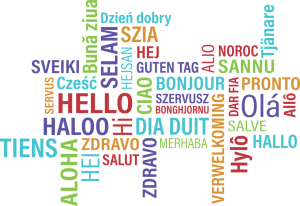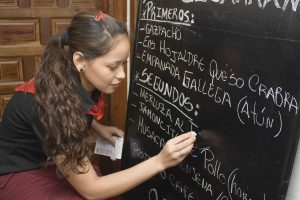Introduction
(This section provides background information about language learning, skip a few paragraphs to “How children become bilingual,” if you wish)
 There is a small window of time in which a person can truly become a fluent native speaker of a language, and that is during childhood. Native speaker fluency means acquiring a language through natural exposure, being able to make subtle grammatical judgments about the language, being able to express ideas in the language in many ways, and being able to say and use all of the sounds of the language. The time when we can learn to do this is roughly from infancy until puberty. Developmentalists continue to explore the reasons for this age constraint, but they mainly have to do with the young brain and its flexibility, the areas of the brain that participate in early language learning, and what the brain has already learned that may interfere with or influence later learning.
There is a small window of time in which a person can truly become a fluent native speaker of a language, and that is during childhood. Native speaker fluency means acquiring a language through natural exposure, being able to make subtle grammatical judgments about the language, being able to express ideas in the language in many ways, and being able to say and use all of the sounds of the language. The time when we can learn to do this is roughly from infancy until puberty. Developmentalists continue to explore the reasons for this age constraint, but they mainly have to do with the young brain and its flexibility, the areas of the brain that participate in early language learning, and what the brain has already learned that may interfere with or influence later learning.
Can adults become fluent in another language? Yes. Adults can certainly learn to speak a new language very well. Yet even those who use it daily rarely achieve full native speaker fluency. One bit of evidence is the tiny “accent” we hear in fluent speakers of our language who are not actually native speakers. The language learning process itself is different for adults. Typically, adults consciously learn rules for a language, memorizing and practicing them, even when they live in a foreign country.
Children acquire language unconsciously. If you listen, you’ll notice they practice and experiment, but we never sit down and teach our children. Did you ever teach your 2-year-old the verb TO BE? Did you go over the differences between using is, be, being, been? Think about it. Of course you didn’t. And your child would have hated it if you had (and would not have understood you and you don’t really consciously know the rules anyway!).
There’s another big difference. When children learn their first language (or languages), they are learning concepts at the same time that they learn words. For example, learning names for numbers also involves learning to count and learning about numbers. For many concepts, adults are translating what they already know into new words, though some ways of viewing and understanding the world vary across cultures opening the way to new ideas along with new words for adult language learners. Learning language and learning about the world are very connected for children.
As a parent, you don’t teach language; you interact with your child. For the most part your child figures it out. We do help though. Adults use simple language with small children, then talk in increasingly complicated ways as children become more competent. This attuned accommodation is the main way we help children learn a language.
It works because the human brain is “language expectant.” That means it expects to be exposed to language during infancy and early childhood and is able to notice and create rules for how language works. One of the great challenges in Artificial Intelligence is trying to figure how to get computers to do this, to come up with accurate rules based on the data they receive. (We’re only just beginning to unravel this in fields like AI and computational linguistics.)
Language itself is a great gift and one of the key abilities that distinguishes humans. Bilingualism is an extra gift that confers some lifelong cognitive and social advantages.
This article explains ways children become bilingual and what to expect if your child is being reared bilingually. Part 2 describes some of the interesting benefits of bilingualism.
Bilingualism defined
Bilingualism simply means having native speaker fluency in two languages. (Trilingualism is the same with three languages.)
How children become bilingual
 Native speaker knowledge of a language happens when children interact with others who are themselves native speakers of that language.
Native speaker knowledge of a language happens when children interact with others who are themselves native speakers of that language.
♥ Learning a language requires a lot of exposure to the language. The key to bilingualism is having enough natural exposure to both languages. TV and screen time do not count! There is a huge amount of research confirming that children cannot and do not learn language from screens. Language learning requires interaction in natural settings with lots of opportunities for the learner to speak and have real, meaningful conversations. (For more on how conversational interactions support brain and cognitive development check out this review of research on boosting brain development)
Bilingual children learn from interacting with native speakers of each of the languages they are acquiring.
The main kinds of bilingual exposure
* Parents are native speakers of different languages
A child whose father is a native speaker of English and whose mother is a native speaker of Mandarin Chinese will learn both English and Mandarin so long as each parent speaks often to the child in their native language. Experts often recommend one parent/one language in bilingual families and this tends to be effective. But some families mix up the languages and speakers when one or both parents are fluent in both languages. It’s okay to experiment and see what works in your home.
* The child has a caregiver who is a native speaker of another language
A child whose nanny, au pair, or grandparents speak Spanish or Korean or whatever with the child, while his own parents speak mainly English, may learn both languages. This is especially true if the child has cousins or friends who speak the other language or if the child has a chance to go to school, even Saturday language school, where the other language is used.
* Living in another country or culture
 A child of English speaking parents living in a country that uses another language can acquire English at home and the other language in the community, interacting with other children, shop keepers, and in schools or early child care where the language of the country is spoken.
A child of English speaking parents living in a country that uses another language can acquire English at home and the other language in the community, interacting with other children, shop keepers, and in schools or early child care where the language of the country is spoken.
* Immersion school or bilingual schools
Some communities in the United States offer schools in which two languages are used, for example both English and Spanish, or in which only a language other than English is used throughout the school day. When these schools provide native speaking teachers and truly use the other language for all subjects and experiences throughout the day (or on alternating days) many children become fluent.
What to expect if your child is learning two languages at once
* Later language Young children learning two languages simultaneously will likely begin to say words a few months later than monolingual children and will likely take a little longer before they combine words into 2- or 3-word phrases.
* Language Mixing Young children may produce phrases that use words from both languages. For example, a child learning both Spanish and English might say “More agua” (‘more water’) or “No es a dog” (‘It isn’t a dog’)
* Smaller vocabularies Bilingual children typically have smaller vocabularies than monolingual children, at least for a few years. On the other hand, they actually know many words; it’s just spread across the two languages since time and brain space are divided across two codes.
* Different language with different people Children may speak mainly English with one parent and mainly the other language with the other parent. This is actually rather useful for the child since it can help her keep the languages separate – English with Daddy, Chinese with mommy. Some children speak English with both parents and the other language with just one parent, the one who is really fluent in it.
A child who is learning a language at home that is different from the one spoken in his community may be very surprised if he meets someone else who knows the home language. They may be delighted or they may be unhappy that someone else knows their “special” language.
* Unequal skill The child’s competence probably won’t be equal in the two languages. One may be stronger than the other. Ultimately, the child who is bilingual really does become competent in both, though one may always be stronger than the other.
* Different language in different situations Children may use the different languages in different situations, for example using Italian for food and family gatherings, and using English on the playground with the same family and friends.
* Being silent in a new language environment A child who moves to a new country and goes to a pre-school or elementary school that uses a “foreign” language may be very silent for a number of months – often about 6 months, then will begin to use the new language with classmates and in school. If these children have the opportunity to stay in the community for several years, they are likely to gain the same fluency as their classmates.
* Mixing languages later on Children who speak one language at home and learn another at school may start to mix up their home language with the school language. For example, a child who speaks Spanish at home and learns English at school may start mixing English into Spanish at home. Don’t worry, the child isn’t confused and they know the difference between the two languages. Adult bilinguals mix their languages too, it’s just part of their fluency and flexibility. Mixing doesn’t mean confusion.
* Near bilingualism When exposure to the two languages is unequal, the child will likely gain real native speaker fluency in one language and near fluency in the other.
The Gift of Bilingualism part 2 explores the effects of bilingualism on cognitive and social development. You can read it here.